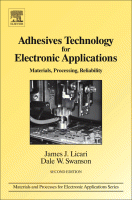Browse content
Table of contents
Actions for selected chapters
- Full text access
- Book chapterAbstract only
1 - Introduction
Pages 1-34 - Book chapterAbstract only
2 - Functions and theory of adhesives
Pages 35-74 - Book chapterAbstract only
Chapter 3 - Chemistry, Formulation, and Properties of Adhesives
Pages 75-141 - Book chapterNo access
Chapter 4 - Adhesive Bonding Processes
Pages 143-216 - Book chapterAbstract only
Chapter 5 - Applications
Pages 217-288 - Book chapterAbstract only
Chapter 6 - Reliability
Pages 289-344 - Book chapterAbstract only
Chapter 7 - Test and Inspection Methods
Pages 345-377 - Book chapterNo access
Appendix
Pages 379-384 - Book chapterNo access
Index
Pages 385-403
About the book
Description
Adhesives are widely used in the manufacture and assembly of electronic circuits and products. Generally, electronics design engineers and manufacturing engineers are not well versed in adhesives, while adhesion chemists have a limited knowledge of electronics. This book bridges these knowledge gaps and is useful to both groups.
The book includes chapters covering types of adhesive, the chemistry on which they are based, and their properties, applications, processes, specifications, and reliability. Coverage of toxicity, environmental impacts and the regulatory framework make this book particularly important for engineers and managers alike.
The third edition has been updated throughout and includes new sections on nanomaterials, environmental impacts and new environmentally friendly ‘green’ adhesives. Information about regulations and compliance has been brought fully up-to-date.
As well as providing full coverage of standard adhesive types, Licari explores the most recent developments in fields such as:
• Tamper-proof adhesives for electronic security devices.
• Bio-compatible adhesives for implantable medical devices.
• Electrically conductive adhesives to replace toxic tin-lead solders in printed circuit assembly – as required by regulatory regimes, e.g. the EU’s Restriction of Hazardous Substances Directive or RoHS (compliance is required for all products placed on the European market).
• Nano-fillers in adhesives, used to increase the thermal conductivity of current adhesives for cooling electronic devices.
Adhesives are widely used in the manufacture and assembly of electronic circuits and products. Generally, electronics design engineers and manufacturing engineers are not well versed in adhesives, while adhesion chemists have a limited knowledge of electronics. This book bridges these knowledge gaps and is useful to both groups.
The book includes chapters covering types of adhesive, the chemistry on which they are based, and their properties, applications, processes, specifications, and reliability. Coverage of toxicity, environmental impacts and the regulatory framework make this book particularly important for engineers and managers alike.
The third edition has been updated throughout and includes new sections on nanomaterials, environmental impacts and new environmentally friendly ‘green’ adhesives. Information about regulations and compliance has been brought fully up-to-date.
As well as providing full coverage of standard adhesive types, Licari explores the most recent developments in fields such as:
• Tamper-proof adhesives for electronic security devices.
• Bio-compatible adhesives for implantable medical devices.
• Electrically conductive adhesives to replace toxic tin-lead solders in printed circuit assembly – as required by regulatory regimes, e.g. the EU’s Restriction of Hazardous Substances Directive or RoHS (compliance is required for all products placed on the European market).
• Nano-fillers in adhesives, used to increase the thermal conductivity of current adhesives for cooling electronic devices.
Key Features
- A complete guide for the electronics industry to adhesive types, their properties and applications – this book is an essential reference for a wide range of specialists including electrical engineers, adhesion chemists and other engineering professionals
- Provides specifications of adhesives for particular uses and outlines the processes for application and curing – coverage that is of particular benefit to design engineers, who are charged with creating the interface between the adhesive material and the microelectronic device
- Discusses the respective advantages and limitations of different adhesives for a varying applications, thereby addressing reliability issues before they occur and offering useful information to both design engineers and Quality Assurance personnel
- A complete guide for the electronics industry to adhesive types, their properties and applications – this book is an essential reference for a wide range of specialists including electrical engineers, adhesion chemists and other engineering professionals
- Provides specifications of adhesives for particular uses and outlines the processes for application and curing – coverage that is of particular benefit to design engineers, who are charged with creating the interface between the adhesive material and the microelectronic device
- Discusses the respective advantages and limitations of different adhesives for a varying applications, thereby addressing reliability issues before they occur and offering useful information to both design engineers and Quality Assurance personnel
Details
ISBN
978-1-4377-7889-2
Language
English
Published
2011
Copyright
Copyright © 2011 Elsevier Inc. All rights reserved
Imprint
William Andrew
